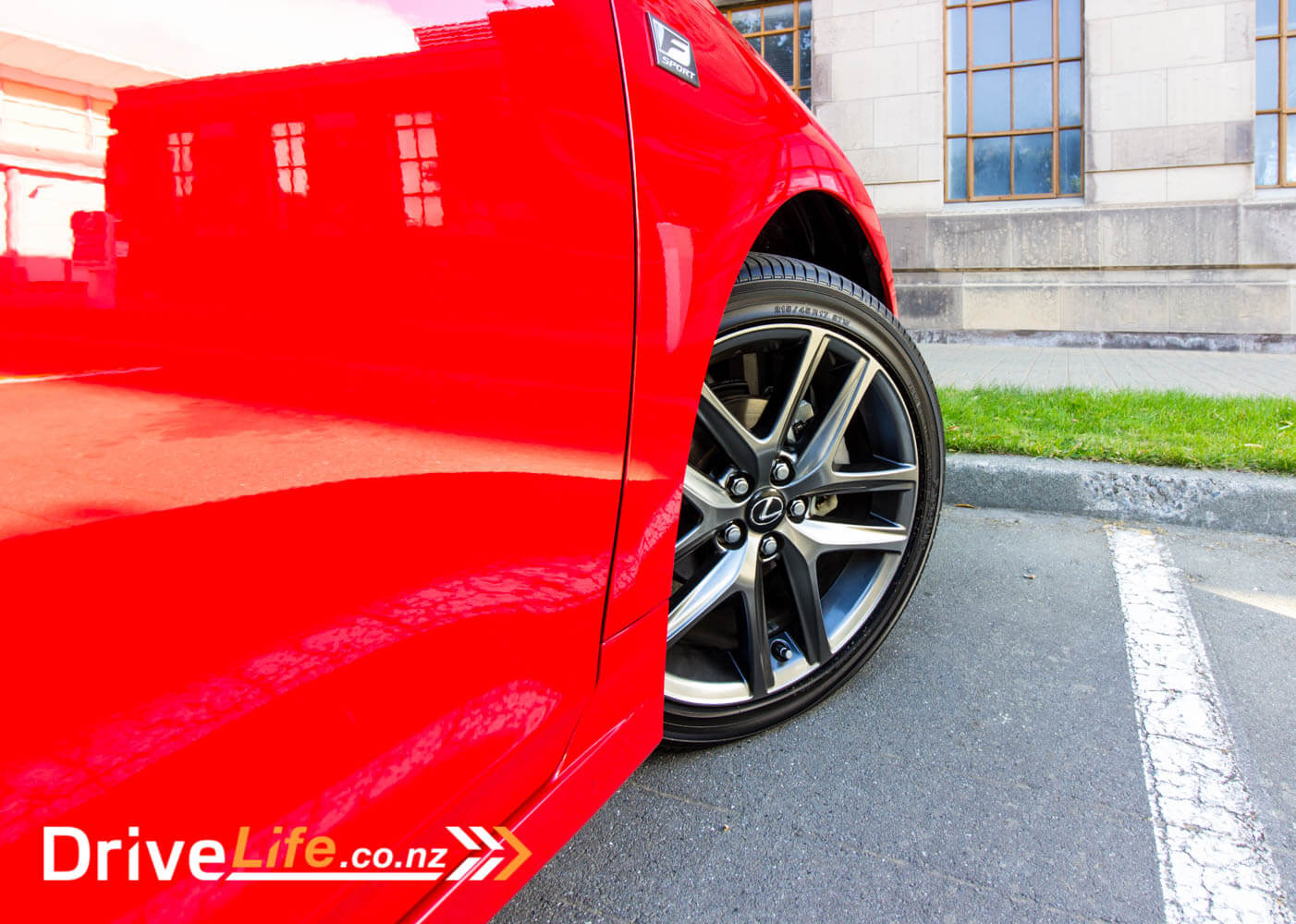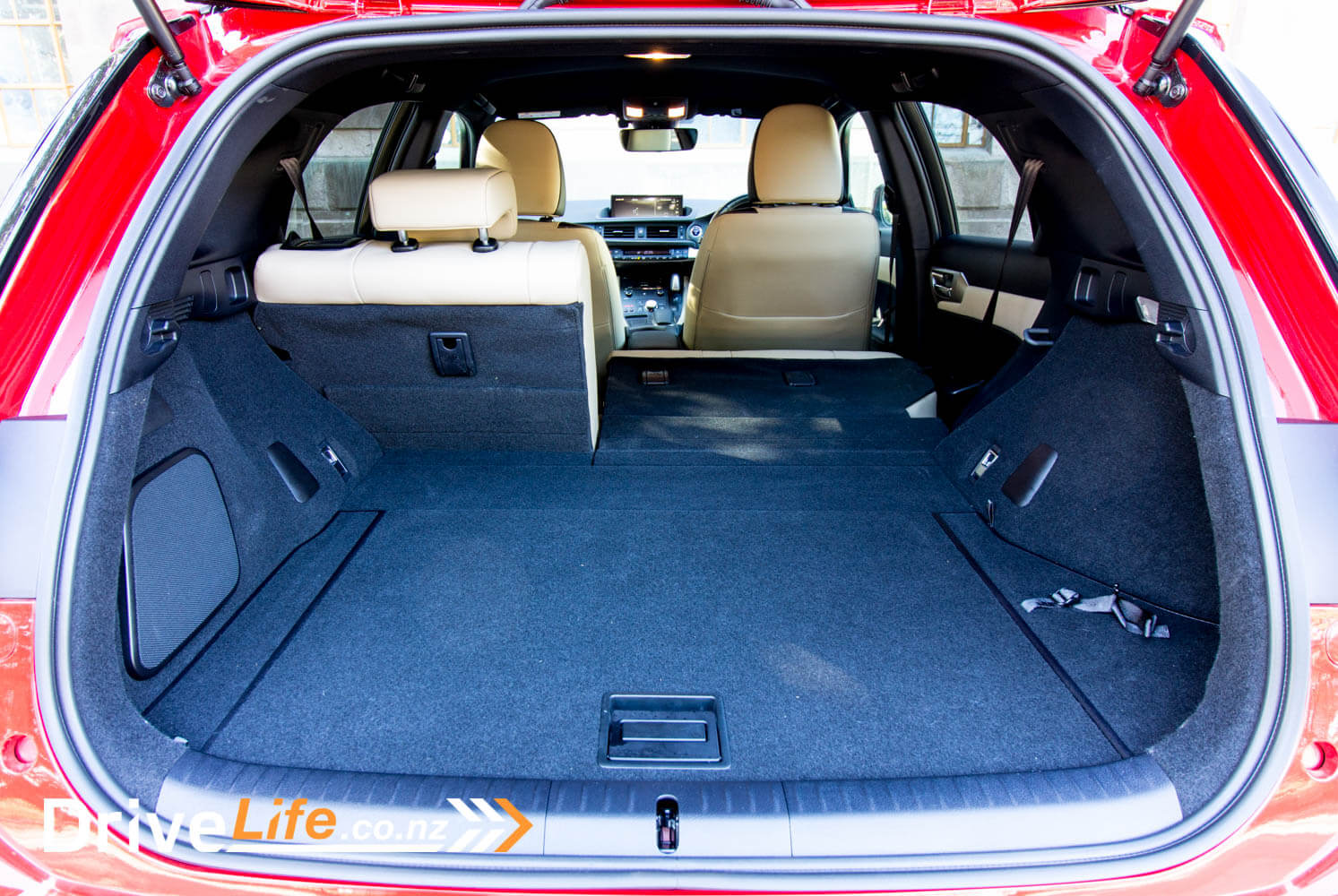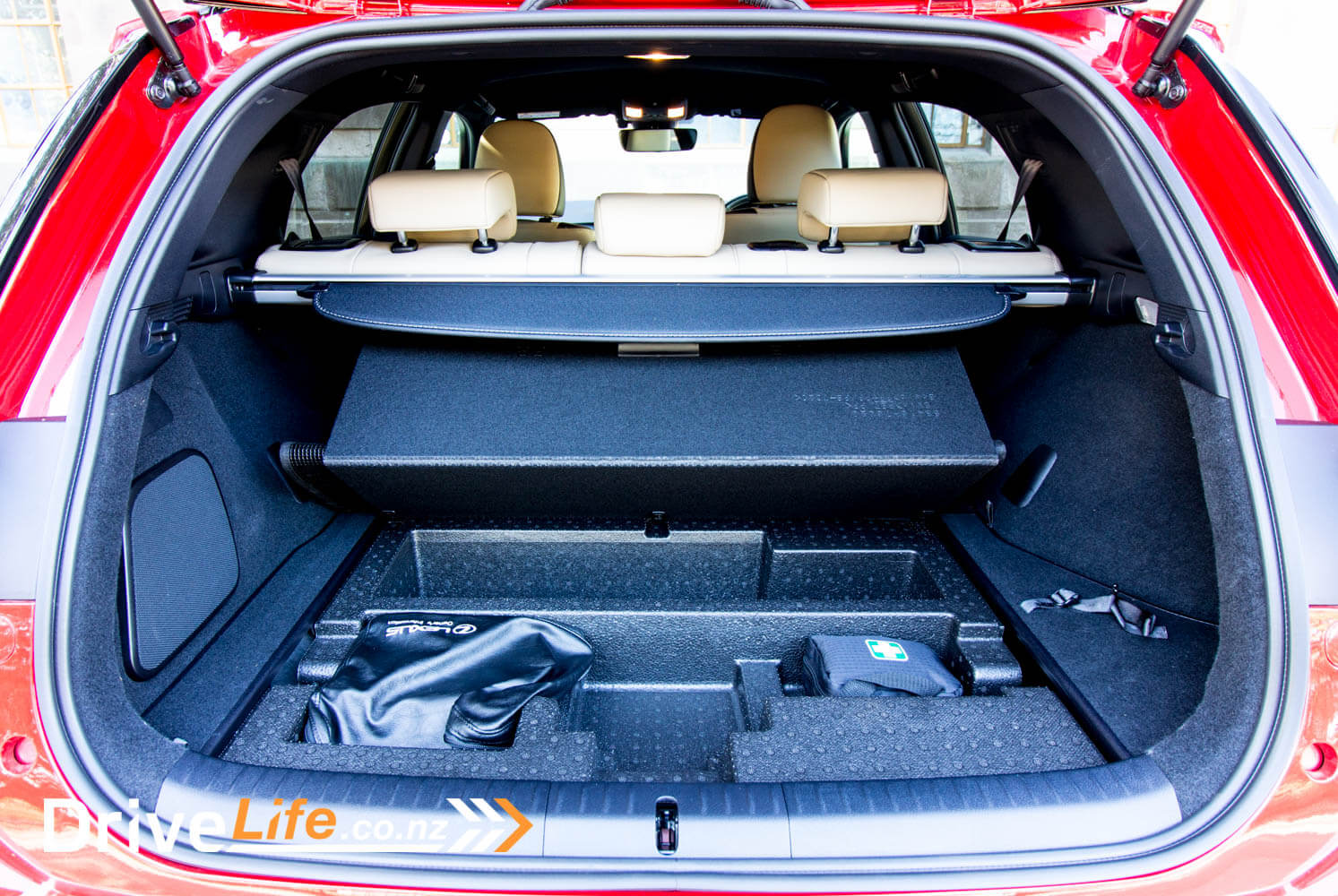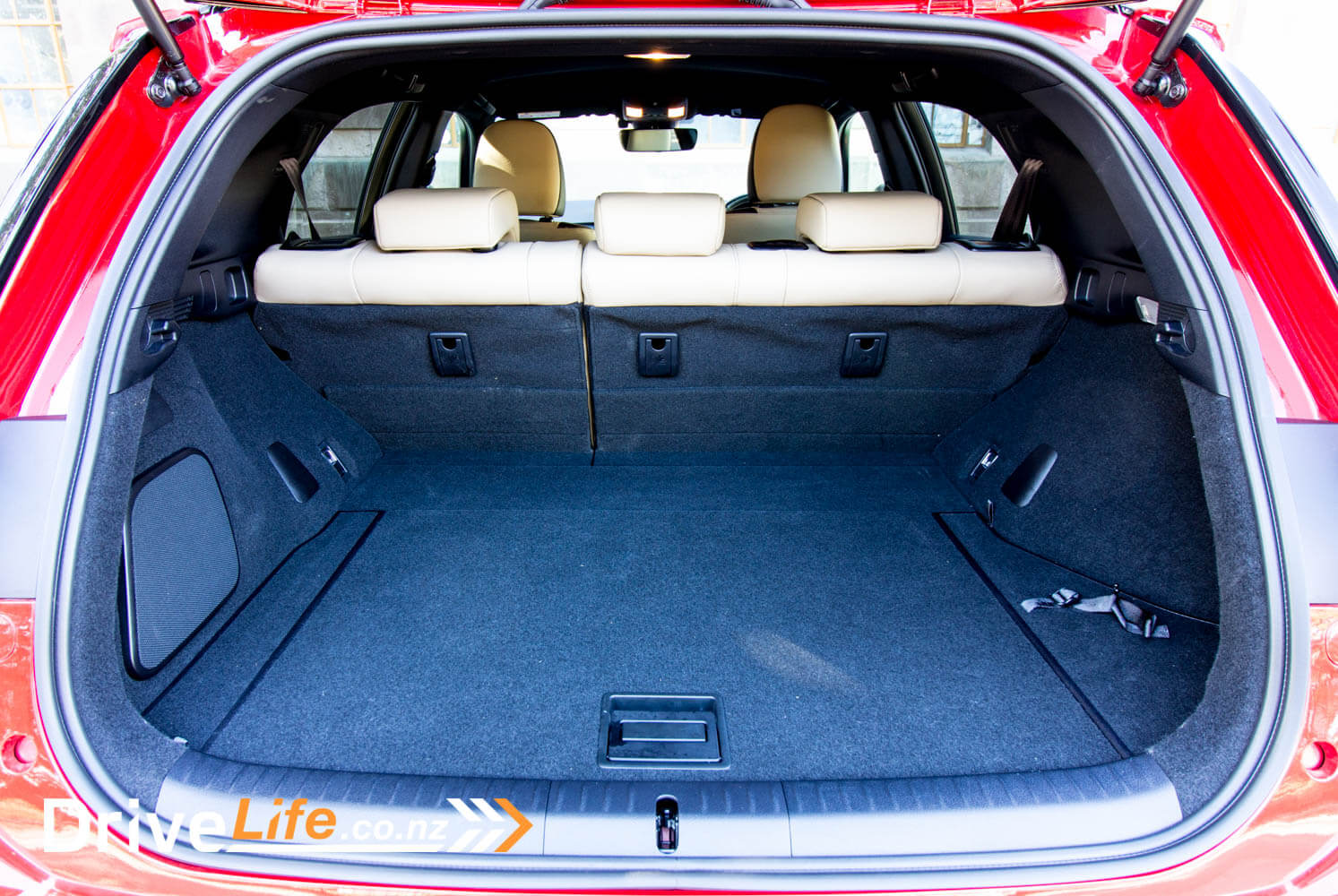I’ve always liked the look of the newer models of car that the CT200 is based on – they look sharp and modern.
When you add the Lexus treatment to the refreshed version of that car – it actually improves it. Futuristic looking even. But is it futuristic to drive?
And more importantly for me, it’s a hybrid – it was time to test the system out properly to see if it is really worthwhile. How much gas can I save driving a hybrid carefully?

The Range
There’s just two models in the Lexus CT200 range – the base model at $51,690 and the F Sport model at $62,690. Lexus New Zealand sent us the F Sport model to test.
Both are fitted with the same hybrid system as the Toyota Corolla, and both have the 1.8-litre, 4-cylinder petrol engine as part of that hybrid setup. This includes a CVT transmission.
New to the 2018 CT200 is Lexus Safety System+, which includes pre-crash safety system, adaptive cruise control, auto high beams, lane departure alert, and vehicle sway warning.

The ‘base’ CT200 comes with standard equipment like a leather steering wheel, electronic brake force distribution, hill start assist, 17” alloys, rear spoiler, keyless entry and start, all windows auto auto up/down, auto wipers, DRLs, auto dimming outside mirrors (with heater, memory, reverse linked tilt, automatic power folding and puddle lamps), climate AC, 4.2” driver’s display, 10.3” central display, 10-speaker DVD/audio, and front and rear parking sensors.
The F Sport model then adds an alarm, alloy pedals, an 8-way electric driver’s seat with 3 memories, 4-way electric passenger’s seat, front seat heaters, some F Sport garnishing, sports tuned shock absorbers and springs, front and rear performance dampers, different alloys, 215/45 R17 Yokohama tyres, LED front fog lamps, LED headlights with auto levelling and headlight cleaners, and leather seats.

There’s no Android Auto or Apple CarPlay on either CT200 model.
There’s a range of colours you can pick for your CT200, and if you buy the F Sport model, you get to choose from a large range of interior colours too. Nine exterior colours are available, surprisingly only two greys, and then black, a couple of whites, red (Caliente), two blue hues and a stunning burnt orange called Lava (F Sport only).

First Impressions
Our test car, finished in Caliente with an Onyx roof, look stunning. Surprisingly, some people didn’t it, but they were firmly in the minority. In this shade of red, it’s quite the looker. Along with that black roof, it’s hard to walk past without taking a second look.
Hard to say if you would do that if it was finished in one of the whites or greys, but our test car looked amazing. Side-on, the wheels really help the car here; they are super-simple, but suit the overall design. A bit sporty but still elegant.
I must admit the CT200F makes me feel quite tall – it’s low down on the ground. It’s only 20mm lower than a hybrid Corolla, but it feels much lower than that.

The Inside
OMG – is that a pedal park brake? This felt so out of place in a high-tech, modern hybrid car, I thought I was dreaming. But I wasn’t – it’s a pedal alright, and is typical Lexus fare. So old school, it doesn’t line up with the rest of the car – but was the only thing that felt out of place.

The rest of the interior is very nicely done, helped along in our test car by the Chateau leather mixed with black on the seats, doors and console. It added a classy touch to the car, and all my passengers commented on just how great it looked. Lucky though for that Chateau leather, as the headlining and pillars are black, so it can be quite dark inside.
The tiny, sporty steering wheel feels great in your hands, with a small F Sport logo at the bottom of the wheel. Along with the racy wheel are the alloy pedals to keep you in a sporty frame of mind.

There’s a new, wider 10.3” central display in the CT200F, and it’s a delight to use. To control it there’s a joystick controller on the centre console, and just in front of it is a nicely padded wrist-rest, so using the joystick on the move isn’t a waste of time, with lots of bumping.
The display itself is crystal clear, and the menu system can be learnt in a few minutes.
There’s some ‘push and pop up’ seat heater controls on the centre console, and it’s completely variable from off to full, to help keep your butt warm.

There were more hard plastics that I could feel from the driver’s seat, on the console and doors especially. It didn’t feel in keeping with the Lexus badge, but they weren’t too obvious to see, but to touch they were.
It was good to see that CT200 has a CD player, as my wife often moans when a car doesn’t have one (i.e. most of them now). Audio quality was surprisingly good, with some excellent bass that can really vibrate the doors, if you want to. Happily, the audio stays on Bluetooth when you leave the car and come back, unlike some. This is how it should be.
Rear legroom is good, and according to my many passengers for the week I had the CT200, very comfortable too.

One feature many Lexus continue to have is the anti-slip mat in boot. It covers the entire boot area and instantly, nothing I put in there slid around. I even just chucked my laptop on the mat – normally a big no-no – and it didn’t move an inch. Such a simple thing, but so effective. Apparently it can be damaged a bit by big cases, so something to keep in mind.

The Drive
Jumping behind the wheel, the first thing I noticed was the tiny volume up/down and track up/down buttons on the steering wheel. After a week, I got used to them to the point where I didn’t have to look down, but they are miniature. Those with uh, chunky, fingers might find they have problems here.
The instrument display is nice and clear, but it was strange to see there is no digital speedo. With such emphasis on not going 1km/h over the limit, it’s almost mandatory now, but there are still cars out there without this – the CT200 included. Hopefully the next model will come with this.

I hit the motorway in the CT200F Sport, and noticed just how quiet it is inside. Wind and tyre noise are nicely subdued, even for a small car where it can be difficult to achieve this. It’s quite a serene car to drive. Helping this serenity along I guess is the hybrid system.
On the motorway, I noticed there’s no Blind Spot Monitoring, which felt like a surprising omission on a top-spec Lexus, even if it is the cheapest model in the range. There’s also no brake auto-hold, which we’ve come to expect on every new model now. It’s such a great safety feature, I was also surprised it wasn’t fitted.

Also, our test car’s adaptive cruise control wouldn’t work. Not the end of the world, and not something we see a lot of in a Lexus. I didn’t want to use it anyway, as I wanted the smoothest possible acceleration at any time, in an attempt to save gas. More on this soon.
I used the SatNav a few times during my week with the car. A trip to Kapiti in the CT200F, and driving on the ‘new’ Expressway, the SatNav showed me as being on farm land. I guess this needs updating. Bonus points though for the CT200 that the SatNav directions are shown right in front of driver in the instrument panel; it’s surprising how many manufacturers don’t do this.

I managed to get in a couple of longish trips in the car, and found the front seats to be extremely comfortable – soft but supportive. No complaints there at all.
The car can be a bit jittery over small bumps, but handles speed bumps with ease. It’s no limo ride but for a small car, it rides quite well on the whole.
We’ve all had a bit of a laugh when it comes to stated fuel economy. Manufacturers seem to have an almost unachievable goal when it comes to litres per hundred kilometres. I’ve lost count of how many cars I’ve tested, but I haven’t lost count of how many times I’ve actually exactly got the same ‘combined’ rating that a manufacturers says a car does: 1. Yes – one. One time only I’ve matched what they say a car should do – and one other time I got a better figure (Mazda MX-5 RF).

So, to the hybrid CT200F. We’ve tested hybrids before, and have never matched the stated rating. When Alan from Drive Life tested the Toyota Corolla hybrid in 2017, he got 5.2. Since the CT200F is based on this car, I might be struggling.
But this time would be different. I was determined to do whatever it took to hit the magic 4.1L/100km Lexus say the car should do. Bring it on.
To achieve this number, I left the AC off for the entire week, unless it was to clear the windscreen, and then it was off straight after that was done. If I was cold, I used the electric seat warmer. If it was hot and I was in town, I wound down a window. If it was hot and I was on the motorway, well I just put up with it. My passengers were not amused. But I was determined.
The Power zone on the Eco gauge was avoided like the plague – I kept that needle from swinging into the Power zone like my life depended on it. I also ran the CT200F in Eco mode for the whole week. Luckily, when you switch the drive mode to Eco, it says there even after turning the car off, so that was great. Was it slow? Oh yeah. But (just) bearably so, and at least I didn’t get tooted at (like I did in the 2018 Mitsubishi Eclipse in Eco mode). Remember this small car weighs in at 1845Kg.
I drove the car with the Drive Mode in B all the time I remembered to turn it on, to give it extra engine braking which equates to more charge into the batteries. This doesn’t stay on when you leave the car, so I had to remember to switch it to ‘B’ every time I started the car.

I made sure I anticipated the traffic as far ahead as I could, to make sure I could avoid touching that power killer, the brake. My week with the Lexus was a solid 50/50 mix of urban and open road, to the point where I’d place a bet on it.
So – did I achieve my target of 4.1L/100km? No. My average for the week was 4.9 over 350km. That’s still pretty good, but I’d love to know what I was doing wrong to not get to Lexus’ magical number. Since Alan got 5.2, I wasn’t that far off his score and yet I went to what I thought were great extremes to achieve maximum fuel efficiency. Does this mean that it’s unlikely anyone could ever get to 4.1L/100Km? Probably, but maybe if you lived in a completely flat town, you’d have a shot at it.
For the additional complexity and cost of the hybrid system, is it worth it? You are putting out less emissions, there’s no doubt about that. But the amount of time you can actually drive without the engine going isn’t as much as you might hope – I’m guessing at best 15%.
A Toyota Corolla 1.8 CVT has a combined rating of 6.1L/100km, so if you managed to achieve the stated number for the CT200, you’d be saving 2L/100km. Worth it? Your call on that one.
The Competition
| Brand/Model | Engine | Power/Torque | Fuel, L/100km | Seats | Boot space, litres (3rd row down where fitted) | Towing capacity, Kg (unbraked/braked) | Price – High to Low |
| Audi A3 e-Tron Sportback | 4-cylinder, 1.4-litre turbo with hybrid system | 110kW/250Nm | 1.6 | 5 | 280 | 750/1400 | $69,900 |
| BMW 225XE Active Tourer | 3-cylinder, 1.5-litre turbo with hybrid system | 165kW/385Nm | 2.1 | 5 | n/a | n/a | $69,800 |
| Lexus CT200 F Sport | 4-cylinder 1.8-litre with hybrid system | 100kW/142Nm | 4.1 | 5 | 360 | Not rated | $62,690 |
| Mini Cooper SE All4 Clubman | 3-cylinder, 1.5-litre turbo with hybrid system | 165kW/385Nm | 2.3 | 5 | 405 | n/a | $59,990 |
The Pros and Cons
| Pros | Cons |
|
|
What do we think of it?
Normally I can whip up this section with ease. Not so much with the CT200 F Sport.
It’s a nice ride, no doubt about that, and I loved the look of our test car in that colour.
But I really thought I’d get better fuel economy, after seven days of trying my hardest to.
And then there’s the cost; the F Sport is over $60K, which puts it among some tasty choices. Not just the cost, but missing safety items like Blind Spot Monitor and brake auto-hold at this cost is very surprising.
I had to think about the Lexus CT200 buyer; maybe the husband has a Lexus SUV, and his wife wants a Lexus too but hates the size of it; these are the ideal CT200 buyer. And she would probably be happy.
For me, it needs some more work on the whole packaging of the car.

2018 Lexus CT200 F Sport
Chevrons 3.5
| Vehicle Type | Medium-sized, 5-door hatchback |
| Starting Price | $51,690 |
| Price as Tested | $62,690 |
| Engine | 1.8-litre, 4-cylinder DOHC petrol, hybrid power system |
| Power, Torque | Combined power, 100kW
142Nm |
| Transmission | CVT |
| 0-100km/h, seconds | 10.9 |
| Spare Wheel | Space saver |
| Kerb Weight, Kg | 1845 |
| Length x Width x Height, mm | 4355x1765x1455 |
| Cargo Capacity, litres | 360L |
| Fuel capacity, litres | 45 |
| Fuel Efficiency | Advertised Spec – combined – 4.1L/100km
Real World Test – combined – 4.9L/100km Low Usage: 0-6 / Medium Usage 6-12 / High Usage 12+ |
| Towing Capacity | Not rated for towing |
| Turning circle, metres | 10.5
Small: 6-10m / Medium 10-12m / Large 12m+ |
| Warranty | 4 years, unlimited kilometres |
| ANCAP Safety Ratings | 5 Star |




































































